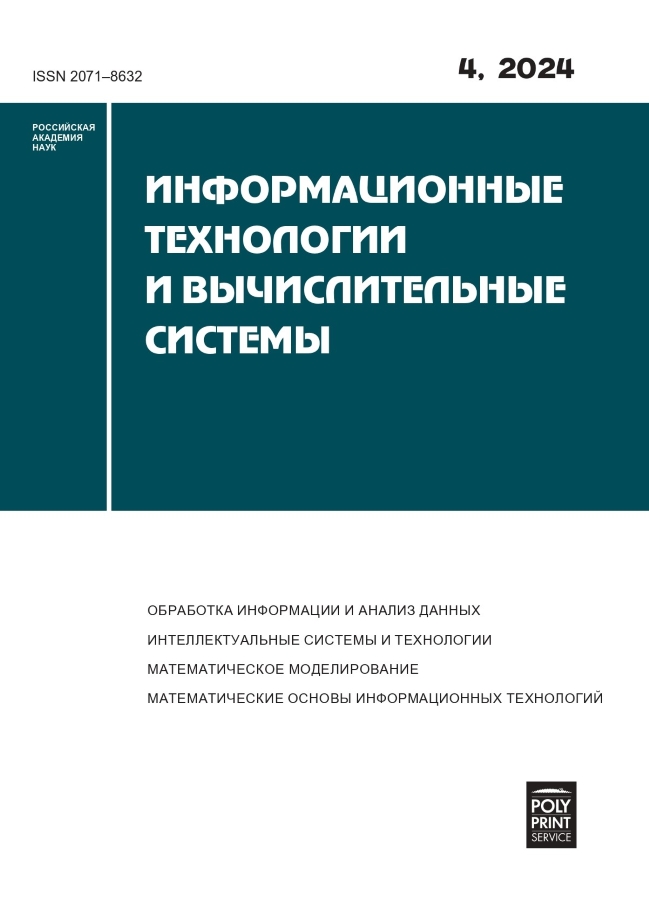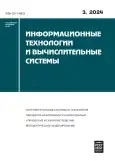Математическое моделирование для развития интеллектуальной транспортной инфраструктуры
- Авторы: Гатауллин Т.М.1, Плешакова Е.С.2, Былевский П.Г.3, Осипов А.В.2, Гатауллин С.Т.2,4
-
Учреждения:
- Новая экономическая ассоциация
- МИРЭА Российский технологический университет
- Московский государственный лингвистический университет
- Центральный экономико-математический институт РАН
- Выпуск: № 3 (2024)
- Страницы: 83-94
- Раздел: Математическое моделирование
- URL: https://journal-vniispk.ru/2071-8632/article/view/286146
- DOI: https://doi.org/10.14357/20718632240308
- EDN: https://elibrary.ru/OYISFY
- ID: 286146
Цитировать
Аннотация
Для повышения достоверности технико-экономических обоснований развития интеллектуальной транспортной инфраструктуры в условиях устойчивого развития мегаполисов необходимо более тщательно учитывать фактические условия эксплуатации одноуровневых пересечений транспортных потоков. Решение этой задачи требует использования передовых экономико-математических инструментов. Математическое описание представляет собой модификацию фундаментальных результатов Э. Бореля и Ф. Хейта, относящихся к простейшему течению событий. Применение этого метода позволит как оценивать экономическую целесообразность расширения существующей транспортной инфраструктуры, так и проектировать новые транспортные объекты. Данный подход может быть применен на этапе первоначальной количественной оценки целесообразности замены одноуровневой развязки транспортных потоков многоуровневой развязкой во избежание экономических потерь.
Об авторах
Тимур Малютович Гатауллин
Новая экономическая ассоциация
Автор, ответственный за переписку.
Email: t.m.gataullin@mtuci.ru
заместитель директора, профессор
Россия, МоскваЕкатерина Сергеевна Плешакова
МИРЭА Российский технологический университет
Email: espleshakova@fa.ru
кандидат технических наук
Россия, МоскваПавел Геннадиевич Былевский
Московский государственный лингвистический университет
Email: pr-911@yandex.ru
кандидат философских наук, доцент
Россия, МоскваАлексей Викторович Осипов
МИРЭА Российский технологический университет
Email: a.v.osipov@mtuci.ru
кандидат физико-математических наук, доцент
Россия, МоскваСергей Тимурович Гатауллин
МИРЭА Российский технологический университет; Центральный экономико-математический институт РАН
Email: s.t.gataullin@mtuci.ru
кандидат экономических наук
Россия, Москва; МоскваСписок литературы
- Ouallane, A.A., Bahnasse, A., Bakali, A., Talea, M. Overview of Road Traffic Management Solutions based on IoT and AI // Procedia Computer Science. Vol. 198, 2022. P. 518 − 523. https://doi.org/10.1016/j.procs.2021.12.279.
- Shamlitskiy, Y., Popov, A., Saidov, N., Moiseeva, K. Transport Stream Optimization Based on Neural Network Learning Algorithms (XIII International Conference on Transport Infrastructure: Territory Development and Sustainability) // Transportation Research Procedia. Vol. 68, 2023. P. 417 − 425. https://doi.org/10.1016/j.trpro.2023.02.056.
- Degrande, T., Vannieuwenborg, F., Verbrugge, S., Colle, D. Deployment of Cooperative Intelligent Transport System infrastructure along highways: A bottom-up societal benefit analysis for Flanders // Transport Policy. Vol. 134, April 2023. P. 94-105. https://doi.org/10.1016/j.tranpol.2023.02.013
- Korablev, V., Gugutishvili, D., Lepekhin A., Gerrits B. Developing a Traffic Management System Architecture Model // Transportation Research Procedia. Vol. 54, 2021. P. 918 − 926. https://doi.org/10.1016/j.trpro.2021.02.147
- Bhouri, N., Aron, M., Lebacque, J. P, Haj-Salem, H. Effectiveness of travel time reliability indicators in the light of the assessment of dynamic managed lane strategy // Journal of Intelligent Transportation Systems. Vol. 21, Issue 6, 2017. P. 492 − 506. https://doi.org/10.1080/15472450.2017.1327815.
- Wang, Z., Delahaye, D., Farges, J.-L., Alam S. Complexity optimal air traffic assignment in multi-layer transport network for Urban Air Mobility operations // Transportation Research Part C: Emerging Technologies. Vol. 142, September 2022, 103776. P. 1 − 23. https://doi.org/10.1016/j.trc.2022.103776.
- Gorodokin, V., Zhankaziev, S., Shepeleva, E., Magdin, K., Evtyukov, S. Optimization of adaptive traffic light control modes based on machine vision (International conference of Arctic transport accessibility: networks and systems) // Transportation Research Procedia. Vol. 57, 2021. P.241 − 249. https://doi.org/10.1016/j.trpro.2021.09.047.
- Glushkov, A., Shepelev V., Slobodin, I., Zhankaziev, S., Myachkov K. Construction of a System for Dynamic Monitoring of Pollutant Emissions by Transport Flows // Transportation Research Procedia. Vol. 68, 2023. P. 543 − 550. https://doi.org/10.1016/j.trpro.2023.02.074.
- Tahaei, H., Afifi, F., Asemi, F., Zaki, F., Anuar, N. B. The rise of traffic classification in IoT networks: A survey // Journal of Network and Computer Applications. Vol. 154, 15 March 2020, 102538. P. 1 − 20.
- https://doi.org/10.1016/j.jnca.2020.102538.
- Oumaima, E. J., Jalel, B. O., Veronique V. A stochastic mobility model for traffic forecasting in urban environments // Journal of Parallel and Distributed Computing. Vol. 165, July 2022. P. 142 − 155. https://doi.org/10.1016/j.jpdc.2022.03.005.
- Ibili, F., Owolabi A. O., Ackaah, W., Massaquoi, A. B. Statistical modelling for urban roads traffic noise levels // Scientific African. Vol. 15, March 2022, e01131. P. 1 − 9. https://doi.org/10.1016/j.sciaf.2022.e01131.
- Rosero, F., Fonseca, N., Mera, Z., López, J.-M. Assessing on-road emissions from urban buses in different traffic congestion scenarios by integrating real-world driving, traffic, and emissions data // Science of The Total Environment. Vol. 863, 10 March 2023, 161002. P. 1 − 17.
- Harrou, F., Zeroual, A., Hittawe, M. M., Sun, Y. Chapter 2 − Road traffic modeling // Road Traffic Modeling and Management. Using Statistical Monitoring and Deep Learning. 2022. P. 15 − 63. https://doi.org/10.1016/B978-0-12-823432-7.00007-0.
- Guchenko, M., Sokhin, N., Skalsky, A., Bartuška, L., Čejka., J. Research of Prognostic Abilities of Local Model of Controlled Process for Traffic Forecasting // Transportation Research Procedia. Vol. 44, 2020. P. 78 − 85. https://doi.org/10.1016/j.trpro.2020.02.012.
- Glushkov, A., Shepelev, V., Vorobyev, F., Mavrin, A., Marusin, A., Evtykov, A. Analysis of the intersection throughput at changes in the traffic flow structure // Transportation Research Procedia. Vol. 57, 2021. P. 192 − 199. https://doi.org/10.1016/j.trpro.2021.09.042.
- Abbracciavento, F., Zinnari, F., Formentin, S., Bianchessi, G., Savaresi, S. M. Multi-intersection traffic signal control: A decentralized MPC-based approach // IFAC Journal of Systems and Control. Vol. 23, March 2023, 100214. P. 1 − 10. https://doi.org/10.1016/j.ifacsc.2022.100214.
- Rudskoy, A., Ilin, I., Prokhorov, F. Digital Twins in the Intelligent Transport Systems // Transportation Research Procedia. Vol.54, 2021. P. 927 − 935. https://doi.org/10.1016/j.trpro.2021.02.152.
- Castaneda, K., Sanchez, O., Herrera, R. F., Pellicer, E., Porras H. BIM-based traffic analysis and simulation at road intersection design // Automation in Construction. Vol. 131, November 2021, 103911. P. 1 − 14. https://doi.org/10.1016/j.autcon.2021.103911.
- Lu, X., Wang, H. Z. J., Zhang, M., Zhou, C., Zhang, H. Modeling impacts of the tunnel section on the mixed traffic flow: A case study of Jiaodong’ao Tunnel in China // Physica A: Statistical Mechanics and its Applications. Vol. 603, 1 October 2022, 127840. P. 1 − 18. https://doi.org/10.1016/j.physa.2022.127840.
- Mfenjou, M. L., Ari, A. A. A., Abdou, W., Spies, F., Kolyang. Methodology and trends for an intelligent transport system in developing countries // Sustainable Computing: Informatics and Systems. Vol. 19, September 2018. P. 96 − 111. https://doi.org/10.1016/j.suscom.2018.08.002.
- Jena, S., Patro S., Dutta M., Bhuyan, P.K. Assessment of service quality at unsignalized intersections using traffic simulation and computational intelligence // Transportation Letters. Vol. 14, Iss. 4, May 2022, P. 365 − 377. https://doi.org/10.1080/19427867.2020.1868179.
- Osipov, A.; Pleshakova, E.; Gataullin, S.; Korchagin, S.; Ivanov, M.; Finogeev, A.; Yadav, V. Deep Learning Method for Recognition and Classification of Images from Video Recorders in Difficult Weather Conditions. Sustainability 2022, 14, 2420. https://doi.org/10.3390/su14042420.
- Spirin, I.V. Organization and management of passenger road transport. In Transportation Organization and Transport Management; Academy: Moscow, Russia, 2005; p. 396.
- Borel E., Sur l'emploi du Théorème de Bernoulli pour Faciliter le Calcul d'un Infinité de Coefficients, Application au Probleme de L' attente a un Guichet, Compt. rend. acad. sci. Paris, 214, 452-456 (1942)
- Saaty, Thomas L. Elements of queueing theory: with applications. Vol. 34203. New York: McGraw-Hill, 1961.
- Haight, Frank A. Mathematical theories of traffic flow. 1965.
- Ivanyuk, V. Forecasting of digital financial crimes in Russia based on machine learning methods. J Comput Virol Hack Tech (2023). https://doi.org/10.1007/s11416-023-00480-3.
- Stack Exchange Network [Electronic resource]: Mathematics \\ https://math.stackexchange.com/questions/1332413/comparing-two-exponential-randomvariables(accessdate 07/31/2023).
Дополнительные файлы










